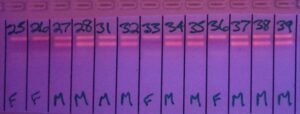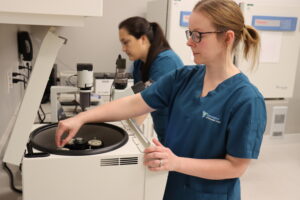Embryo sexing is applied on farm as a later step of traditional embryo transfer programs. Every cell in the embryo (just like every living cell in an organism) contains a complete copy of all the DNA required to produce a complete individual. Each cell from a male embryo contains the male (Y) chromosome. Sexing technology relies on testing for the presence of this Y chromosome.
There are several techniques for determining bovine embryo sex. Cells can be taken from an embryo and Y chromosome segments can be replicated and visualized. This is achieved by simply cutting a small number of cells off of each embryo or by inserting a needle into each embryo to remove cells. Alternatively sex can be determined by fluorescent staining of the entire embryo.
Our lab determines embryo sex by cutting cells off an embryo and replicating segments of Y chromosome using a DNA amplification process called Polymerase Chain Reaction (PCR). After collecting and sorting the embryos, a small biopsy of 2 – 4 cells is removed from each embryo using a specially designed inverted microscope and an ultra-sharp splitting blade connected to an electronically controlled micromanipulator.
The biopsy is used for sex determination while the embryo is retained for final processing. Biopsied embryos can be frozen, or remain in culture while the next steps are carried out.
Test tubes, each carrying a biopsy from one embryo, are run through a PCR. This will multiply specific segments of DNA, including fragments on the male (Y) chromosome. The DNA of these chromosome fragments is incubated for approximately one hour in a thermocycler to be multiplied many times.
 The DNA of the embryo needs to be multiplied to have the mass required to see it during the final phase of this sexing technology: gel electrophoresis. The content of each test tube containing the multiplied DNA is placed into a separate well in a prepared gel. An electric current is introduced across the gel, which causes all fragments of DNA to move with the current. The DNA fragments move according to electrical charge and fragment size. The male DNA fragments are smaller and thus separate from other (autosomal) DNA fragments. It takes approximately 20 minutes for the male DNA fragments to fully separate from the autosomal DNA, and a bright band of male DNA will show up when the gel is illuminated with ultraviolet light. By reading the specific positions of the bands of DNA, we can now tell which embryo is male and which embryo is female. The accuracy of this test is 98%.
The DNA of the embryo needs to be multiplied to have the mass required to see it during the final phase of this sexing technology: gel electrophoresis. The content of each test tube containing the multiplied DNA is placed into a separate well in a prepared gel. An electric current is introduced across the gel, which causes all fragments of DNA to move with the current. The DNA fragments move according to electrical charge and fragment size. The male DNA fragments are smaller and thus separate from other (autosomal) DNA fragments. It takes approximately 20 minutes for the male DNA fragments to fully separate from the autosomal DNA, and a bright band of male DNA will show up when the gel is illuminated with ultraviolet light. By reading the specific positions of the bands of DNA, we can now tell which embryo is male and which embryo is female. The accuracy of this test is 98%.
The sex of embryo can then be selected for transfer.




 The DNA of the embryo needs to be multiplied to have the mass required to see it during the final phase of this sexing technology: gel electrophoresis. The content of each test tube containing the multiplied DNA is placed into a separate well in a prepared gel. An electric current is introduced across the gel, which causes all fragments of DNA to move with the current. The DNA fragments move according to electrical charge and fragment size. The male DNA fragments are smaller and thus separate from other (autosomal) DNA fragments. It takes approximately 20 minutes for the male DNA fragments to fully separate from the autosomal DNA, and a bright band of male DNA will show up when the gel is illuminated with ultraviolet light. By reading the specific positions of the bands of DNA, we can now tell which embryo is male and which embryo is female. The accuracy of this test is 98%.
The DNA of the embryo needs to be multiplied to have the mass required to see it during the final phase of this sexing technology: gel electrophoresis. The content of each test tube containing the multiplied DNA is placed into a separate well in a prepared gel. An electric current is introduced across the gel, which causes all fragments of DNA to move with the current. The DNA fragments move according to electrical charge and fragment size. The male DNA fragments are smaller and thus separate from other (autosomal) DNA fragments. It takes approximately 20 minutes for the male DNA fragments to fully separate from the autosomal DNA, and a bright band of male DNA will show up when the gel is illuminated with ultraviolet light. By reading the specific positions of the bands of DNA, we can now tell which embryo is male and which embryo is female. The accuracy of this test is 98%. The Abbotsford Veterinary Clinic is one of only two facilities in Canada with an in vitro fertilization laboratory certified for international export of embryos.
The Abbotsford Veterinary Clinic is one of only two facilities in Canada with an in vitro fertilization laboratory certified for international export of embryos.